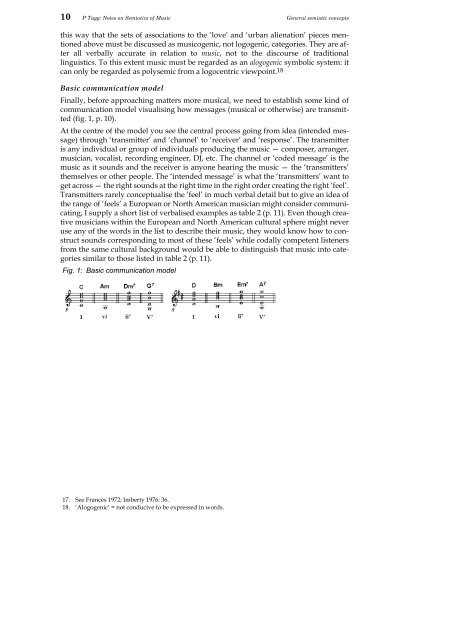Introductory notes to the Semiotics of Music - Philip Tagg's home page
Introductory notes to the Semiotics of Music - Philip Tagg's home page
Introductory notes to the Semiotics of Music - Philip Tagg's home page
You also want an ePaper? Increase the reach of your titles
YUMPU automatically turns print PDFs into web optimized ePapers that Google loves.
10 P Tagg: Notes on <strong>Semiotics</strong> <strong>of</strong> <strong>Music</strong> General semiotic concepts<br />
this way that <strong>the</strong> sets <strong>of</strong> associations <strong>to</strong> <strong>the</strong> ‘love’ and ‘urban alienation’ pieces mentioned<br />
above must be discussed as musicogenic, not logogenic, categories. They are after<br />
all verbally accurate in relation <strong>to</strong> music, not <strong>to</strong> <strong>the</strong> discourse <strong>of</strong> traditional<br />
linguistics. To this extent music must be regarded as an alogogenic symbolic system: it<br />
can only be regarded as polysemic from a logocentric viewpoint. 18<br />
Basic communication model<br />
Finally, before approaching matters more musical, we need <strong>to</strong> establish some kind <strong>of</strong><br />
communication model visualising how messages (musical or o<strong>the</strong>rwise) are transmitted<br />
(fig. 1, p. 10).<br />
At <strong>the</strong> centre <strong>of</strong> <strong>the</strong> model you see <strong>the</strong> central process going from idea (intended message)<br />
through ‘transmitter’ and ‘channel’ <strong>to</strong> ‘receiver’ and ‘response’. The transmitter<br />
is any individual or group <strong>of</strong> individuals producing <strong>the</strong> music — composer, arranger,<br />
musician, vocalist, recording engineer, DJ, etc. The channel or ‘coded message’ is <strong>the</strong><br />
music as it sounds and <strong>the</strong> receiver is anyone hearing <strong>the</strong> music — <strong>the</strong> ‘transmitters’<br />
<strong>the</strong>mselves or o<strong>the</strong>r people. The ‘intended message’ is what <strong>the</strong> ‘transmitters’ want <strong>to</strong><br />
get across — <strong>the</strong> right sounds at <strong>the</strong> right time in <strong>the</strong> right order creating <strong>the</strong> right ‘feel’.<br />
Transmitters rarely conceptualise <strong>the</strong> ‘feel’ in much verbal detail but <strong>to</strong> give an idea <strong>of</strong><br />
<strong>the</strong> range <strong>of</strong> ‘feels’ a European or North American musician might consider communicating,<br />
I supply a short list <strong>of</strong> verbalised examples as table 2 (p. 11). Even though creative<br />
musicians within <strong>the</strong> European and North American cultural sphere might never<br />
use any <strong>of</strong> <strong>the</strong> words in <strong>the</strong> list <strong>to</strong> describe <strong>the</strong>ir music, <strong>the</strong>y would know how <strong>to</strong> construct<br />
sounds corresponding <strong>to</strong> most <strong>of</strong> <strong>the</strong>se ‘feels’ while codally competent listeners<br />
from <strong>the</strong> same cultural background would be able <strong>to</strong> distinguish that music in<strong>to</strong> categories<br />
similar <strong>to</strong> those listed in table 2 (p. 11).<br />
Fig. 1: Basic communication model<br />
17. See Francès 1972; Imberty 1976: 36.<br />
18. ‘Alogogenic’ = not conducive <strong>to</strong> be expressed in words.














